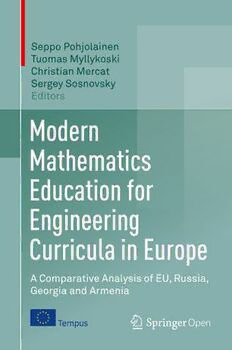
Modern Mathematics Education for Engineering Curricula in Europe PDF
Preview Modern Mathematics Education for Engineering Curricula in Europe
Seppo Pohjolainen Tuomas Myllykoski Christian Mercat Sergey Sosnovsky Editors Modern Mathematics Education for Engineering Curricula in Europe Modern Mathematics Education for Engineering Curricula in Europe Seppo Pohjolainen • Tuomas Myllykoski (cid:129) Christian Mercat (cid:129) Sergey Sosnovsky Editors Modern Mathematics Education for Engineering Curricula in Europe A Comparative Analysis of EU, Russia, Georgia and Armenia Editors SeppoPohjolainen TuomasMyllykoski LaboratoryofMathematics LaboratoryofMathematics TampereUniversityofTechnology TampereUniversityofTechnology Tampere,Finland Tampere,Finland ChristianMercat SergeySosnovsky UniversitéLyon1 UtrechtUniversity IREMdeLyon,BaˆtimentBraconnier Utrecht,TheNetherlands VilleurbanneCedex,France ThisprojecthasbeenfundedwithsupportfromtheEuropeanCommission.Thispublication reflectstheviewsonlyoftheauthor,andtheCommissioncannotbeheldresponsibleforany usewhichmaybemadeoftheinformationcontainedtherein. ISBN978-3-319-71415-8 ISBN978-3-319-71416-5 (eBook) https://doi.org/10.1007/978-3-319-71416-5 LibraryofCongressControlNumber:2018943911 MathematicsSubjectClassification(2010):97Uxx ©TheEditor(s)(ifapplicable)andTheAuthor(s)2018.Thisbookisanopenaccesspublication. Open Access This bookis licensed under the terms of the Creative Commons Attribution 4.0Inter- nationalLicense(http://creativecommons.org/licenses/by/4.0/), whichpermitsuse,sharing,adaptation, distribution andreproduction inanymediumorformat,aslong asyougive appropriate credit tothe originalauthor(s)andthesource,providealinktotheCreativeCommonslicenseandindicateifchanges weremade. Theimages or other third party material in this book are included in the book’s Creative Commons license,unlessindicatedotherwiseinacreditlinetothematerial.Ifmaterialisnotincludedinthebook’s CreativeCommonslicenseandyourintendeduseisnotpermittedbystatutoryregulationorexceedsthe permitteduse,youwillneedtoobtainpermissiondirectlyfromthecopyrightholder. Theuseofgeneraldescriptivenames,registerednames,trademarks,servicemarks,etc.inthispublication doesnotimply,evenintheabsenceofaspecificstatement,thatsuchnamesareexemptfromtherelevant protectivelawsandregulationsandthereforefreeforgeneraluse. Thepublisher,theauthors,andtheeditorsaresafetoassumethattheadviceandinformationinthisbook arebelievedtobetrueandaccurateatthedateofpublication.Neitherthepublishernortheauthorsor theeditorsgiveawarranty,expressorimplied,withrespecttothematerialcontainedhereinorforany errorsoromissionsthatmayhavebeenmade.Thepublisherremainsneutralwithregardtojurisdictional claimsinpublishedmapsandinstitutionalaffiliations. Printedonacid-freepaper This book is published under the imprint Birkhäuser, www.birkhauser-science.com by the registered companySpringerInternationalPublishingAGpartofSpringerNature. Theregisteredcompanyaddressis:Gewerbestrasse11,6330Cham,Switzerland Preface Modern science, technology, engineering and mathematics (STEM) education is facing fundamental challenges. Most of these challenges are global; they are not problemsonlyforthedevelopingcountries.Addressingthesechallengesinatimely andefficientmannerisofparamountimportanceforanynationaleconomy. Mathematics,asthelanguageofnatureandtechnology,isanimportantsubjectin theengineeringstudies.Despitethefactthatitsvalueiswellunderstood,students’ mathematicalskills havedeterioratedinrecentdecadesin thewesternworld.This reflectsinstudents’slowprogressingandhighdrop-outpercentagesinthetechnical sciences. The remedy to improve the situation is a pedagogical reform, which entails that learning contexts should be based on competencies, engineering students motivationshouldbeaddedbymakingengineeringmathematicsmoremeaningfully contextualized, and modern IT-technology should be used in a pedagogically appropriatewaysoastosupportlearning. This book providesa comprehensiveoverview of the core subjects comprising mathematical curricula for engineering studies in five European countries and identifies differences between two strong traditions of teaching mathematics to engineers.Itisacollectiveeffortofexpertsfromadozenuniversitiestakingacritical lookatvariousaspectsofhighermathematicaleducation. The two EU Tempus-IV projects—MetaMath (www.metamath.eu) and Math- GeAr (www.mathgear.eu)—take a deep look at the current methodologies of mathematicseducationfortechnicalandengineeringdisciplines.Theprojectsaimat improvingthe existing mathematicscurriculain Russian, Georgianand Armenian universities by introducingmodern technology-enhancedlearning (TEL) methods and tools, as well as by shifting the focus of engineering mathematics education fromapurelytheoreticaltraditiontoamoreapplication-basedparadigm. MetaMath and MathGeAr have brought together mathematics educators, TEL specialistsandexpertsineducationqualityassurancefrom21organizationsacross 6countries.Acomprehensivecomparativeanalysisoftheentirespectrumofmath courses in the EU, Russia, Georgia and Armenia has been conducted. Its results allowed the consortium to pinpoint issues and introduce several modifications in v vi Preface theircurriculawhilepreservingtheoverallstrongstateoftheuniversitymathemat- icseducationinthesecountries.Themethodology,theprocedure,andtheresultsof thisanalysisarepresentedhere. ThisprojecthasbeenfundedwithsupportfromtheEuropeanCommission.This publication reflects the views only of the authors, and the Commission cannot be held responsible for any use which may be made of the information contained therein. ThisprojecthasbeenfundedwithsupportfromtheEuropeanCommission.This publicationreflectstheviewsonlyoftheauthor,andtheCommissioncannotbeheld responsibleforanyusewhichmaybemadeoftheinformationcontainedtherein. Tampere,Finland SeppoPohjolainen Tampere,Finland TuomasMyllykoski Villeurbanne,France ChristianMercat Utrecht,theNetherlands SergeySosnovsky Contents 1 Introduction................................................................. 1 2 MethodologyforComparativeAnalysisofCourses.................... 33 SergeySosnovsky 3 Overview of Engineering Mathematics Education forSTEMinRussia ........................................................ 39 YuryPokholkov,KseniyaZaitseva(Tolkacheva),MikhailKuprianov, IuriiBaskakov,SergeiPozdniakov,SergeyIvanov,AntonChukhnov, AndreyKolpakov,IlyaPosov,SergeyRybin,VasiliyAkimushkin, Aleksei Syromiasov, Ilia Soldatenko, Irina Zakharova, andAlexanderYazenin 4 OverviewofEngineeringMathematicsEducationforSTEM inGeorgia ................................................................... 55 DavidNatroshvili 5 OverviewofEngineeringMathematicsEducationforSTEM inArmenia................................................................... 63 IshkhanHovhannisyan 6 OverviewofEngineeringMathematicsEducationforSTEM inEU......................................................................... 69 7 CaseStudiesofMathEducationforSTEMinRussia.................. 91 8 CaseStudiesofMathEducationforSTEMinGeorgia................ 141 9 CaseStudiesofMathEducationforSTEMinArmenia............... 169 10 OverviewoftheResultsandRecommendations ........................ 185 SergeySosnovsky,ChristianMercat,andSeppoPohjolainen vii About the Editors SeppoPohjolainen isa(emeritus)professorattheLaboratoryofMathematicsof theTampereUniversityofTechnology.Hisresearchinterestsincludemathematical controltheory,mathematicalmodelingandsimulation,developmentandtheuseof informationtechnologytosupportlearning.Hehasledseveralresearchprojectsand writtenanumberofjournalarticlesandconferencepapersonallabove-mentioned fields. Tuomas Myllykoski is a Master of Science and a Teacherof Mathematicsat the Laboratory of Mathematics of the Tampere University of Technology. His focus has been on the development and use of learning tools in mathematics, and his currentresearch interests are in the fields of data science, educationalpsychology andpersonality. Christian Mercat is professor in the laboratory Sciences, Société, Historicité, ÉducationetPratiques(S2HEP,EA4148)anddirectoroftheInstituteforResearch on Mathematics Education (IREM). He trains mathematics teachers at the École SupérieureduProfessoratetdel’éducation(ESPE).Hismaininterestismathemat- icsteachingthatrespectsthecreativepotentialofstudents.Hetookpartinseveral research projects on technology-enhanced learning and creative mathematical thinking such as, lately, the mcSquared project (http://www.mc2-project.eu/). He publishedanumberofarticlesandgaveconferencetalksonthesubject,aswellas onhismainmathematicalspecialty:discretedifferentialgeometry. Sergey Sosnovsky is an assistant professor of software technology for learning and teaching at the Institute of Information and Computing Sciences of Utrecht University.Hehasco-authoredmorethan90peer-reviewedpublicationsontopics related to technology-enhanced learning and adaptive information systems. Dr. Sosnovsky served on the programming committees of several conferences and workshops dedicated to Adaptive and Intelligent Educational Technologies. He has built up a strong record of participation in research projects supportedby US and EU funding agencies on various aspects of developing AI-based educational technologies,includingadaptivesupportoflearningprocessesandsemanticaccess ix x AbouttheEditors to instructional resources. Dr. Sosnovsky holds a M.Sc. degree in Information Systems from Kazan State Technological University (Kazan, Russia) and a PhD degree in Information Sciences from University of Pittsburgh (Pittsburgh, PA, USA).He isa receiverofthe EUMarie-CurieInternationalIncomingFellowship. HecoordinatedtheprojectsMetaMathandMathGeAr,whichareatthebasisofthis book. Chapter 1 Introduction 1.1 Mathematics Educationin EUfor STEMDisciplines SeppoPohjolainen((cid:2)) Tampere University of Technology (TUT), Laboratory of Mathematics, Tampere, Finland e-mail:seppo.pohjolainen@tut.fi Good competency in mathematics is important in science, technology and economy;mathematicscanbeconsideredasthelanguageofnatureandtechnology and also is an important methodology in economics and social sciences. A study by Hanushek and Wößman [21] shows that the quality of education has a strong positive influence on economic growth. In their research, students’ skills were measured using 13 international tests, which included mathematics, science, and reading.AnOECDreportonmathematicsinindustry[42]statesthattheremarkable development of the natural sciences and of engineering since the Renaissance is a consequence of the fact that all nature’s known laws can be expressed as mathematicalequations.TheFinancialTimesoutlinedtheirnewsonFebruary13th, 2006,as“Mathematicsoffersbusinessaformulaforsuccess”. Despite the fact that the value of mathematics in society and economics is understood, in recent decades students’ mathematics skills have deteriorated in western countries. The report “Mathematics for the European Engineer” [50] by theEuropeanSocietyforEngineeringEducationSEFI1statesthatthisphenomenon prevailsinEurope.AccordingtotheSEFIreport,universitiesinthewesternworld 1SEFI(http://www.sefi.be). ©TheAuthor(s)2018 1 S.Pohjolainenetal.(eds.),ModernMathematicsEducationforEngineering CurriculainEurope,https://doi.org/10.1007/978-3-319-71416-5_1
